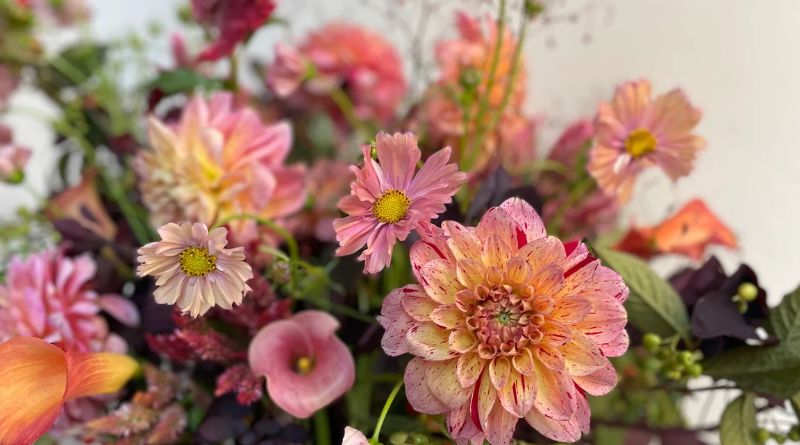Floral design is more than just the simple act of arranging flowers. It’s a form of artistic expression, blending nature’s beauty with creativity to create visually stunning compositions. One of the key principles that many professional floral designers use is the concept of floral design that show line. Understanding this principle is essential for anyone interested in floral art, whether you’re a beginner looking to enhance your arrangement skills or a seasoned designer seeking to refine your technique.
Table of Contents
In this article, we will explore what floral design that show line means, its importance in floral compositions, how to effectively use it, and why it’s an essential concept for achieving harmony and balance in flower arrangements.
What is Floral Design That Show Line?
Floral design that show line refers to the use of lines in a flower arrangement that create a visual path or flow for the viewer’s eyes. These lines guide the viewer’s attention, shaping the way they experience the composition. Just like in any other form of design or art, lines in floral arrangements help to establish a sense of structure, movement, and rhythm.
In floral design, lines can be created in several ways:
- Actual Lines: These are the physical stems, branches, and flowers themselves that form shapes and angles within the arrangement. For example, tall, spiky flowers like snapdragons or delphiniums create vertical lines, while curved branches or stems of certain flowers form sweeping, curved lines.
- Implied Lines: These are lines that don’t physically exist but are suggested through the way flowers are arranged. The arrangement of petals, leaves, or other elements can suggest the direction of a line, even if no physical line exists.
- Psychological Lines: These lines evoke certain feelings or emotions. For example, horizontal lines might give a sense of calm or stability, while diagonal lines can evoke a sense of movement or energy.
The role of these lines is not just about shaping the composition. They help in guiding the viewer’s gaze, creating balance, and ensuring that the arrangement is visually pleasing. A well-executed floral design that show line ensures the viewer’s eye is directed naturally through the piece, highlighting important features while maintaining visual harmony.
Why is Floral Design That Show Line Important?
The importance of floral design that show line in flower arrangements lies in its ability to create structure and interest. Flowers are naturally organic and often unpredictable, which makes it easy for designs to become chaotic or unbalanced. By understanding how to use lines effectively, floral designers can create compositions that feel cohesive and aesthetically pleasing. Here are some reasons why floral design that show line is essential:
1. Creates Movement and Direction
Lines in floral arrangements help lead the viewer’s eye from one part of the design to another. Without clear direction, an arrangement might feel stagnant or uninteresting. Lines—whether straight, curved, or diagonal—create a sense of movement and flow, guiding the eye naturally through the design.
2. Establishes Balance
A key component of any good floral design is balance. Lines help achieve this by breaking up space and filling it in a visually appealing way. Horizontal lines can provide stability, while vertical and diagonal lines create contrast and interest. Using a combination of these lines helps achieve equilibrium within the arrangement.
3. Adds Visual Interest
Lines add visual interest by creating a focal point and leading the viewer’s eye to it. A simple arrangement can be transformed into something dynamic and captivating by using lines creatively to draw attention to particular flowers or elements. The right combination of lines can elevate an arrangement from a basic bunch of flowers to an artful masterpiece.
4. Guides the Viewer’s Eye
Without lines, it would be difficult to determine where to look in a floral arrangement. The human eye naturally follows lines, so using them strategically helps in guiding the viewer’s focus to specific elements. A well-designed line structure allows the viewer to take in the entire arrangement, savoring its beauty in a natural flow.
Types of Lines in Floral Design
Understanding the different types of lines and how they can be used in floral arrangements is crucial for creating impactful designs. Below are some of the most commonly used lines in floral design that show line:
1. Vertical Lines
Vertical lines are the most commonly used lines in floral design. They give an arrangement a sense of height and elegance. These lines evoke feelings of strength, power, and stability. Flowers such as tall lilies, orchids, and gladiolus naturally create vertical lines. They are often used in arrangements that need to make a bold statement or when creating the height of the design is a priority.
- Effect: Creates a sense of height, dignity, and strength.
- Common Flowers: Delphiniums, snapdragons, irises, and tall grasses.
2. Horizontal Lines
Horizontal lines are used to create stability, calmness, and balance within an arrangement. They are typically found in floral designs that are more compact or low-set, often in centerpieces or table arrangements. These lines can be formed using shorter flowers or foliage that spread outward horizontally.
- Effect: Evokes stability and calmness.
- Common Flowers: Roses, chrysanthemums, sunflowers, and foliage.
3. Diagonal Lines
Diagonal lines add energy and movement to an arrangement. They break up the symmetry created by vertical and horizontal lines and introduce a sense of dynamic motion. Diagonal lines can also add drama and emphasis to specific areas of the design.
- Effect: Adds movement, energy, and excitement.
- Common Flowers: Calla lilies, orchids, and other long, slender flowers.
4. Curved Lines
Curved lines bring softness, elegance, and fluidity to floral arrangements. These lines often feel more natural and organic, resembling the curves found in nature. Curved lines are perfect for designs meant to convey beauty, grace, or romanticism.
- Effect: Brings elegance, fluidity, and softness.
- Common Flowers: Roses, peonies, and soft, flowing vines or branches.
5. Spiral Lines
Spiral lines create a sense of continuity and movement. They often represent the flow of nature and the cycle of life, making them an excellent choice for floral designs that aim to be reflective, spiritual, or symbolic.
- Effect: Creates flow and unity.
- Common Flowers: Ferns, spiraling vines, or circular flower arrangements.
How to Incorporate Floral Design That Show Line into Your Arrangements
Incorporating floral design that show line into your flower arrangements can be done in several ways. Here are some tips on how to effectively use lines in your designs:
1. Consider the Shape and Structure of Flowers
When designing your arrangement, think about the natural lines of the flowers you’re using. Long-stemmed flowers will create vertical lines, while curved flowers like orchids and roses create softer, more fluid lines. Incorporating both types of lines creates a balanced design.
2. Use Foliage to Define Lines
Foliage can help define the lines in your arrangement. Tall leaves can create vertical lines, while trailing vines can create a sense of movement with curved or diagonal lines.
3. Play with Scale and Proportion
Larger flowers can be used to emphasize certain lines, while smaller flowers can fill in spaces. Use larger flowers to form the primary lines, then fill in with smaller ones to support the design’s balance and flow.
4. Create Contrast
To make your arrangement more visually striking, use contrasting lines. For example, if your design includes a lot of vertical lines, break it up with diagonal or curved elements. Contrast helps to create interest and prevents the arrangement from feeling monotonous.
5. Experiment with Negative Space
Incorporating negative space into your floral design is a powerful way to emphasize the lines in the arrangement. The empty spaces between flowers allow the viewer’s eye to follow the natural flow of the lines without distraction.
FAQs About Floral Design That Show Line
1. What is the purpose of using lines in floral design?
Lines in floral design help direct the viewer’s gaze, establish balance, and create visual interest. They provide structure, guide the flow of the design, and contribute to the overall aesthetic.
2. Can I use just one type of line in my floral design?
While you can use only one type of line, combining different lines (vertical, horizontal, diagonal, curved) often leads to more dynamic and visually appealing designs.
3. How can I use lines to create balance in an arrangement?
By mixing different types of lines (vertical, horizontal, curved), you can achieve a harmonious balance between energy and calmness. For instance, vertical lines can be balanced by softer horizontal or curved lines.
4. How do I choose the right flowers to create specific lines?
Choose flowers based on their natural growth patterns. Tall flowers like delphiniums and lilies create vertical lines, while roses and peonies offer soft, rounded shapes. Experiment with flowers that can emphasize the types of lines you want in your design.
5. What is the best way to incorporate implied lines?
Implied lines are suggested by the arrangement of flowers or foliage. For example, you can arrange flowers in such a way that their positioning creates the illusion of a line, even if no actual line is present.
Conclusion
Floral design that show line is a powerful concept in the art of floral arrangements. By understanding and utilizing lines—whether vertical, horizontal, diagonal, or curved—you can create compositions that are visually engaging, balanced, and harmonious.



